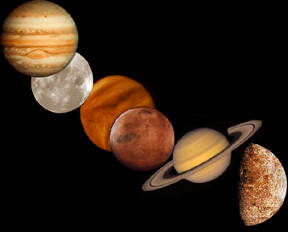A full-sky map of the oldest light in the universe.
Click on image for full size
Image courtesy NASA/WMAP Science Team
The Oldest Light in the Universe
News story originally written on February 14, 2003
NASA scientists have taken a "snapshot" picture of the oldest light
in the universe. The picture shows what is left of light given off during the big
bang. The light is over 13 billion years old! This old light has lost energy
over the years, and is now microwave radiation.
The picture was made using data from a spacecraft called WMAP. WMAP measured
the age of the universe. Scientists now think the universe is about 13.7 billion
years old. Data from WMAP also tells us that the first stars
started to shine about 200 million years after the big bang. That is much
earlier than scientists expected.
You might also be interested in:

It was another exciting and frustrating year for the space science program. It seemed that every step forward led to one backwards. Either way, NASA led the way to a great century of discovery. Unfortunately,
...more
The Space Shuttle Discovery lifted off from Kennedy Space Center on October 29th at 2:19 p.m. EST. The weather was great as Discovery took 8 1/2 minutes to reach orbit. This was the United States' 123rd
...more
A moon was discovered orbiting the asteroid, Eugenia. This is only the second time in history that a satellite has been seen circling an asteroid. A special mirror allowed scientists to find the moon
...more
Will Russia ever put the service module for the International Space Station in space? NASA officials want an answer from the Russian government. The necessary service module is currently waiting to be
...more
A coronal mass ejection (CME) happened on the Sun early last month. The material that was thrown out from this explosion passed the ACE spacecraft. The SWICS instrument on ACE has produced a new and very
...more
J.S. Maini of the Canadian Forest Service called forests the "heart and lungs of the world." This is because forests filter air and water pollution, absorb carbon dioxide, release oxygen, and maintain
...more
In late April through mid-May 2002, all five naked-eye planets are visible at the same time in the night sky! This is includes Mercury which is generally very hard to see. You won't want to miss this!
...more















